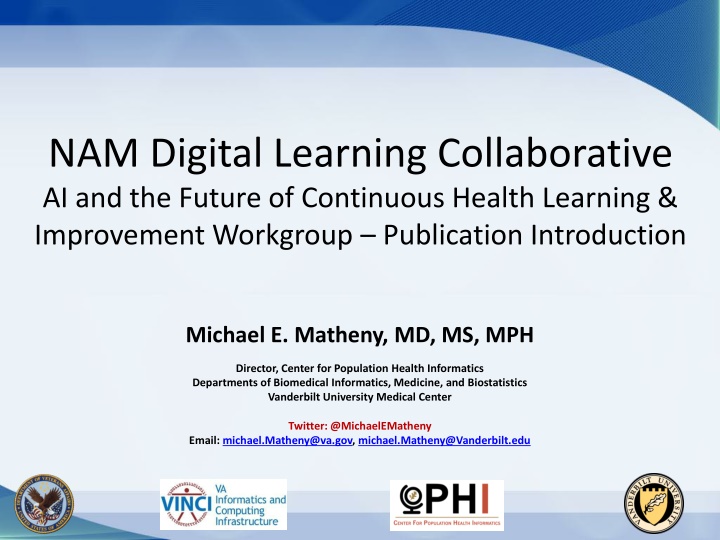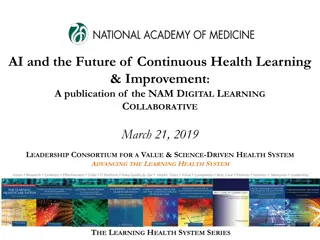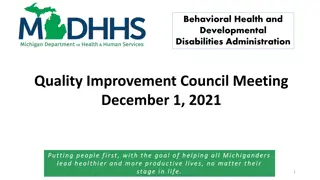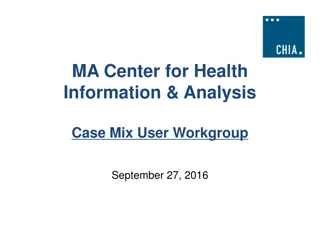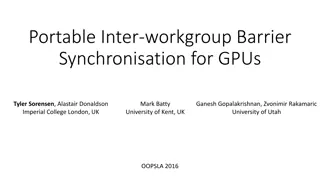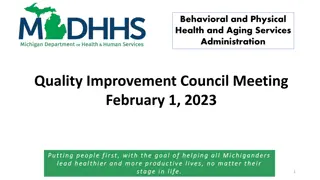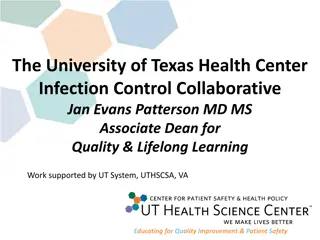Advancing Continuous Health Learning: NAM Digital Learning Collaborative AI Workgroup
Explore the intersection of AI and healthcare with the NAM Digital Learning Collaborative AI Workgroup, focusing on enhancing data integration, AI model development, and accelerating progress in continuous health learning. The workgroup aims to develop a reference document for stakeholders to understand and promote the use of AI/ML in healthcare, highlighting areas for further research and implementation.
Download Presentation

Please find below an Image/Link to download the presentation.
The content on the website is provided AS IS for your information and personal use only. It may not be sold, licensed, or shared on other websites without obtaining consent from the author.If you encounter any issues during the download, it is possible that the publisher has removed the file from their server.
You are allowed to download the files provided on this website for personal or commercial use, subject to the condition that they are used lawfully. All files are the property of their respective owners.
The content on the website is provided AS IS for your information and personal use only. It may not be sold, licensed, or shared on other websites without obtaining consent from the author.
E N D
Presentation Transcript
NAM Digital Learning Collaborative AI and the Future of Continuous Health Learning & Improvement Workgroup Publication Introduction Michael E. Matheny, MD, MS, MPH Director, Center for Population Health Informatics Departments of Biomedical Informatics, Medicine, and Biostatistics Vanderbilt University Medical Center Twitter: @MichaelEMatheny Email: michael.Matheny@va.gov, michael.Matheny@Vanderbilt.edu
DLC AI & Future of Continuous Health Learning and Improvement Workgroup Original Charter: to explore the fields of AI and their applications in health and health care strategies to enhance data integration to advance healthcare AI practical challenges to AI model development and implementation opportunities for accelerating progress
Initial Workgroup Membership Sonoo Thadaney, Stanford (Workgroup Co-chair) Michael Matheny, Vanderbilt (Workgroup co-chair) John Burch, JLB Associates Wendy Chapman, University of Utah Jonathan Chen, Stanford University Len D Avolio, Cyft Sharam Ebadollahi, IBM Watson Health Group Hossien Estiri, Harvard Medical School Steve Fihn, University of Washington Jim Fackler, John Hopkins School of Medicine Seth Hain, Epic Brigham Hyde, Precision Health Intelligence Edmund Jackson, HCA Hongfang Liu, Mayo Clinic Doug McNair, Cerner Eneida Mendonca, University of Wisconsin Madison Sean Khozin, FDA Matthew Quinn, HRSA Robert E. Samuel, Aetna Bob Tavares, Emmi Solutions Howard Underwood, Anthem) Daniel Yang, Moore Foundation Jonathan Perlin, CMO HCA, DLC Co-Chair Reed Tuckson, Tuckson Health Con., DLC Co-Chair Wendy Nilsen, NSF Joachim Roski, Booz Allen Hamilton Howard Underwood, Anthem Daniel Yang, Moore Foundation Doug Badzik, Department of Defense) Carlos Blanco, National Institute on Drug Abuse Paul Bleicher, OptumLabs Carla Brodley, Northeastern University Tim Estes, Digital Reasoning Daniel Fabbri, Vanderbilt University Medical Center Kenneth R. Gersing, NIH Michael Howell, Google Brigham Hyde , Precision Health Intelligence Javier Jimenez, Sanofi Jennifer MacDonald, VA Nigam H. Shah, Stanford) David Sontag, MIT Noel Southall, NIH Shawn Wang, Anthem Maryan Zirkle, PCORI
NAM Workgroup Publication Objectives & Scope Develop a reference document for model developers, clinical implementers, clinical users, and regulatory and policy makers to: understand strengths and limitations of AI/ML promote use of these methods and technologies within the healthcare system Highlight areas of future work needed in research, implementation science, and regulatory bodies to facilitate broader use of AI/ML in healthcare
NAM DLC AI Publication: Organization TOPIC Leads Jonathan Perlin, Reed Tuckson Danielle Whicher, Mahnoor Ahmed Sonoo Thadaney, Michael Matheny NAM DLC NAM Program Office Publication Editors Chapter 1: Introduction Chapter 2: History of AI Chapter 3: Promise/Opportunities for AI Chapter 4: Pitfalls/Challenges for AI Chapter 5: AI Development & Validation Chapter 6: AI Deployment in Clinical Settings Steve Fihn, Andy Auerbach Chapter 7: Regulatory & Policy Issues Chapter 8: Conclusions & Key Needs Sonoo Thadaney, Michael Matheny Edmund Jackson, Jim Fackler Joachim Roski, Wendy Chapman Eneida Mendonca, Jonathan Chen Hongfang Liu, Nigam Shah Doug McNair, Nicholson Price Sonoo Thadaney, Michael Matheny
AI: What Do We Mean? https://www.legaltechnology.com/latest-news/artificial-intelligence-in-law-the-state-of-play-in-2015/
Health & Healthcare Settings Direct Encounter-Based Care Non-Traditional Settings: CVS, Home Population Health Management Back Office Healthcare Administration Patient/Consumer Facing Technologies
Target Audiences Direct Care Providers Patients and their Caregivers Healthcare System Leadership & Admin Data Scientists (Developers) Clinical Informatics (Implementers) Legislative & Regulatory Bodies Third Party Payors
Chapter 2: History & Current State of AI Discusses history of AI with examples from other industries Summarize the growth, maturity, and adoption in healthcare as compared to other industries. Target general audience
Chapter 3: Promise & Potential Impact of AI Focus on the utility of AI for improving healthcare delivery Discuss near-future opportunities and potential gains from the use of AI Target General Audiences
Chapter 4: Potential Unintended Consequences of AI Focus on the potential unintended consequences of AI on: work processes culture equity / fairness patient-provider relationship workforce composition & skills Target General Audiences
Chapter 5: AI Modeling Development & Validation Most Technical Chapter Topics process for developing and validating models choice of data, variables, model complexity performance metrics, validation Target Model Developers
Chapter 6: Deploying AI in Clinical Settings Focus on implementing and maintaining AI within production healthcare domains Address issues of: Software development Integration into a Learning Healthcare System Applications of Implementation Science Model Maintenance & Surveillance over Time Target Healthcare System Leaders & Implementers
Chapter 7: Regulatory & Policy Considerations Summarize key legislative and regulatory considerations for the use of AI in health care Identify strengths and weaknesses in current framework Discuss legal liability concerns Make recommendations to address gaps
Chapter 8: Conclusions & Key Needs build on and summarize key & cross-cutting themes from previous chapters Recommend key areas for: Moving the field forward Highlight over-arcing these from chapters
Publication Timeline NAM Meeting Publication Workgroup Kick-Off 02/2018 Content Scope Established Chapter Outlines Completed Chapter Draft Versions NAM Meeting Publication Revisions NAM/External Reviews Tentative Release 11/2017 05/2018 07/2018 09-12/2018 01/2019 01-02/2019 03/2019 04/2019
Mental Framework for This Meeting Out of Scope: Discussion of Major Content Additions/Subtractions In Scope: Changes to Framing / Addressing Imbalance / Voice of Chapters In Scope: Focus on Recommendations Identify and discuss modifications, additions, and subtractions as each chapter is discussed Be mindful of a desired balance between stakeholder groups (patients, providers, administrators, regulatory bodies, etc.) If you felt like the opportunity to discuss a point passed and major themes, please send it to us in an email, or write it down and give it to us during a break mahmed@nas.edu, dwhicher@nas.edu
Thank You NAM Leadership Victor Zhau Michael McGinnis DLC Leadership Jonathan Perlin Reed Tuckson NAM Staff Leads Danielle Whicher Mahnoor Ahmed DLC Clinical AI Workgroup Members
